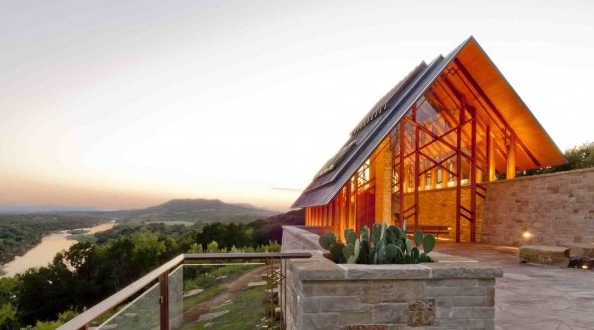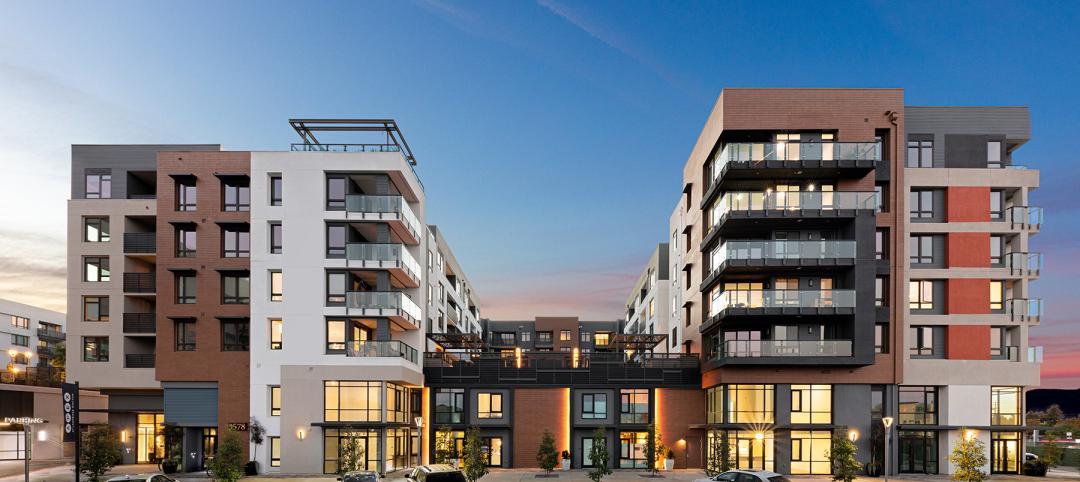From 100-foot roof spans to novel reclaimed wood installations, the winners of the 2013 National Wood Design Awards push the envelope in wood design.
WoodWorks, an initiative of the Wood Products Council, presented the awards at the San Francisco Bay Area Wood Solutions Fair in late January. Winners were recognized across eight categories: commercial wood design; wood design engineering; green building with wood; institutional wood design; interior beauty of wood; multi-story wood design; wood school design; and traditional wood design.
Here's a recap of the eight National Award winners (for more photos, visit www.woodworks.org):
1. Commercial Wood Design Award
LeMay – America’s Car Museum – Tacoma, WA
Large Architecture – Los Angeles, CA

LeMay – America’s Car Museum is a 165,000-square-foot, $60 million structure designed to preserve history and celebrate the world’s automotive culture. The spacious facility houses up to 350 cars, trucks and motorcycles from private owners, corporations, and the LeMay collection.
To create a roof that spans over 100 feet and is more than 300 feet long, the architect initially assumed that steel beams were necessary. But that would have required fireproofing, which was expensive. To keep costs within budget, the roof was converted to a design-build system. Western Wood Structures designed the roof structure using large glulam beams, which were panelized on the ground and erected into place.
The timber roof offered the advantage of Type IV Heavy Construction, which eliminated the need for additional fire protection. The hue of the Douglas fir glulam also created a warm aesthetic, contrasting nicely with the concrete flooring, while coming in at an installed cost of $41.80 per square foot. This created more than $600,000 in project savings.
2. Green Building with Wood Design Award
The David and Lucile Packard Foundation – Los Altos, CA
EHDD – San Francisco, CA

At this 49,000-square-foot company headquarters in Los Altos, California, extensive use of wood emphasizes the building as a healthy and sustainable work environment for the staff. For the exterior in particular, the design reflects California's tradition of wood buildings—underlining the emphasis on indoor-outdoor lifestyle and love for natural materials. This is also referenced in the building layout. The building is centered around a wooded courtyard, with operable doors all around.
The wood adds warmth and a smaller scale to the building with its subtle variations in tone and textural qualities. However, the modern application uses dark reveals to create sub-division and larger scale pattern in the facade, resulting in a taut, crisp and refined skin. The selection of wood as the main exterior cladding material, as well as the interior, was an important strategy for reaching the LEED Platinum rating.
3. Institutional Wood Design Award
Central Oregon Community College Science Center – Bend, OR
Yost Grube Hall Architecture – Portland, OR

The Science Center is a 46,000-square-foot, $12.5 million facility. It includes three general purpose classrooms; dedicated labs for biology, chemistry, geology and physics; herbarium; learning resource center; faculty offices and a wide variety of informal student study areas designed to encourage collaboration and interaction. The campus and region both have a strong tradition of wood buildings, with the surrounding context characterized by structures clad in wood shingles and siding. The Science Center continues this palette with a more contemporary expression, while taking advantage of the deep reservoir of local experience in wood construction. The use of a renewable resource and certified wood products was a primary focus for the design team and owner and helped the project to achieve a Gold rating through the Earth Advantage Commercial program.
4. Multi-Story Wood Design Award
University of Washington West Campus Student Housing – Seattle, WA
Mahlum – Seattle, WA

At the University of Washington, nearly 1,700 beds in three residential halls and two apartment buildings define a new mixed-use campus precinct, which includes a restaurant, grocery store, conference center, cafe, fitness center and academic support center. Employing an exception in the Seattle Building Code, the project team was able to build five stories of light wood-frame construction over two stories of concrete. This allowed the designers to meet the project's ambitious goals within the owner's very tight budget. Using wood as a primary structural material also sped construction times, cut carbon emissions and utilized local materials. Careful attention to detailing created a building envelope that is air and water tight, thermally efficient, and durable. This project represents a paradigm shift at the University and its first embrace of large-scale light wood-frame construction. The buildings are a testament to the fact that wood construction can save resources, time and money, while creating elegant urban structures that contribute to city and campus vitality.
5. Wood School Design Award
Duke School – Durham, NC
DTW Architects & Planners – Durham, NC

The 42,100-square-foot, $5,000,000 project used a combination of glulam and wood-frame structure to give the owner a cost-effective, long-lasting and low-maintenance facility. The use of exposed wood structure and roof decking created a warm and natural educational environment that is greatly appreciated by students, staff and parents. The school site is surrounded by Duke Forest and the highly visible wood interiors were a natural fit for the project. The use of wood was also an important part of the sustainable design strategy for a number of reasons—including a desire to use renewable local materials, wood's contribution to energy efficiency, and the fact that carbon is sequestered in the wood products for the lifetime of the building.
6. Interior Beauty of Wood Design Award
University of Oregon Ford Alumni Center – Eugene, OR
Opsis Architecture – Portland, OR

The Ford Alumni Center is the new gateway to the University of Oregon (UO). The 60,000-square-foot, $28.3 million Center houses the Alumni Association, University Office of Development and the UO Foundation offices, all brought together for the first time in an interconnected, collaborative workplace. No finish material better captures the feeling of Oregon than wood. However, perhaps the most important reason to use wood was that it tells the story of the university. Some of the wood was donated by alumni in the timber and manufacturing industries. The red oak was harvested from a campus tree that fell on the provost's car. The cedar was from a tree that stood for decades in front of the oldest building on campus. The stair treads were reclaimed from a classic Oregon business. And the Douglas fir and Madrone showcase Oregon's homegrown natural resources.
7. Wood Design Engineering Award
Wawona Sculpture – Seattle, WA
Arup Engineers – Seattle, WA

The Wawona Sculpture has a compelling narrative as it connects Seattle's rich timber and maritime history with an inspiring vision for innovation and the future. The sculpture utilized Douglas fir wood planks reclaimed from a recently dismantled Schooner, which was built in 1897 and is now on the National Register of Historic Places. More than 200 4x12 boards were used, totaling approximately 5,000 pounds of wood. The sculpture is 56 feet tall, suspended as a pendulum from the building's roof trusses, kinetic, interactive for the museum patrons to touch and walk through, and built to withstand earthquakes in a region of high seismicity—a significant engineering challenge and a unique example of digital design-to-construction technique. The use of reclaimed wood speaks to its sustainability and longevity as well as long-term carbon sequestration.
8. Traditional Use of Wood Design Award
Rio Roca Chapel – Palo Pinto County, TX
Maurice Jennings + Walter Jennings Architecture – Fayetteville, AR

The Rio Roca Chapel is 1,080 square feet and seats up to 50 people. Southern Yellow Pine was selected for the structural and exterior elements, and the rich, warm color of clear red oak was chosen for the interior. 4x6 Southern Yellow Pine decking provides lateral bracing between the structural bents, and 2x8 pine flitch beams support the roof. The built-in pews are made from clear red oak plywood and solid stock, and the lectern and registry is clear red oak plywood and trim. Most of the wood is exposed, requiring it to not only serve a structural purpose but an aesthetic one. The wood and steel in the project work in conjunction to provide the structure of the building, using each material's strengths for the specific application.
More on the winners at: www.woodworks.org.
Related Stories
| Aug 29, 2022
Montana becomes first U.S. state to approve 3D printing in construction
Montana is the first U.S. state to give broad regulatory approval for 3D printing in building construction.
Giants 400 | Aug 29, 2022
Top 175 Multifamily Sector Architecture + AE Firms for 2022
Perkins Eastman, Solomon Cordwell Buenz, KTGY, and Gensler top the ranking of the nation's largest multifamily sector architecture and architecture/engineering (AE) firms for 2022, as reported in Building Design+Construction's 2022 Giants 400 Report. Note: This ranking includes all multifamily sector work, including apartments, condos, student housing, and senior living facilities.
| Aug 26, 2022
Idaho Building Code Board considers gutting large part of state energy code
Idaho Building Code Board considers gutting large part of state energy code.
Multifamily Housing | Aug 25, 2022
7 things to know about designing for Chinese multifamily developers
Seven tips for designing successful apartment and condominium projects for Chinese clients.
Giants 400 | Aug 25, 2022
Top 155 Apartment and Condominium Architecture Firms for 2022
Solomon Cordwell Buenz, KTGY, Gensler, and AO top the ranking of the nation's largest apartment and condominium architecture and architecture/engineering (AE) firms for 2022, as reported in Building Design+Construction's 2022 Giants 400 Report.
University Buildings | Aug 25, 2022
Higher education, striving for ‘normal’ again, puts student needs at the center of project planning
Sustainability and design flexibility are what higher education clients are seeking consistently, according to the dozen AEC Giants contacted for this article. “University campuses across North America are commissioning new construction projects designed to make existing buildings and energy systems more sustainable, and are building new flexible learning space that bridge the gap between remote and in-person learning,” say Patrick McCafferty, Arup’s Education Business Leader–Americas East region, and Matt Humphries, Education Business Leader in Canada region.
| Aug 25, 2022
New York City’s congestion pricing aims to reduce traffic, cut carbon
Officials recently released an environmental assessment that analyzes seven different possible pricing schemes for New York City’s congestion pricing program.
Sponsored | BD+C University Course | Aug 24, 2022
Solutions for cladding performance and supply issues
This course covers design considerations and cladding assembly choices for creating high-performance building envelopes — a crucial element in healthy, energy-efficient buildings.
| Aug 24, 2022
California’s investment in ‘community schools’ could transform K-12 education
California has allocated $4.1-billion to develop ‘community schools’ that have the potential to transform K-12 education.
| Aug 24, 2022
Architecture Billings Index slows but remains healthy
For the eighteenth consecutive month architecture firms reported increasing demand for design services in July, according to a new report today from The American Institute of Architects (AIA).

















